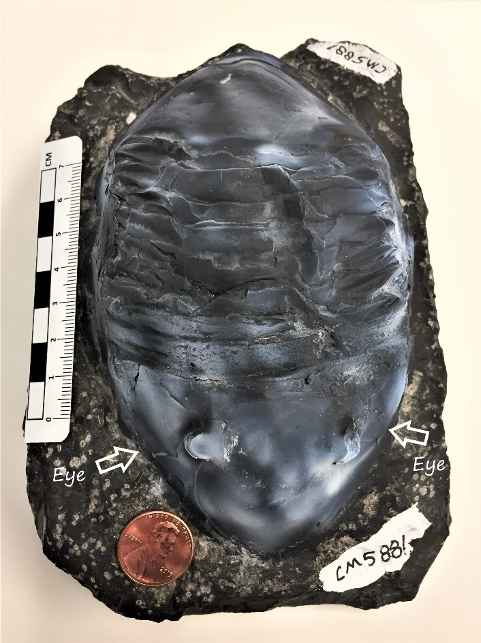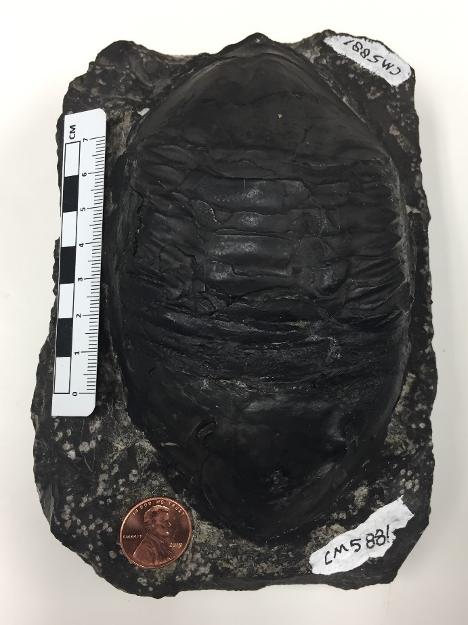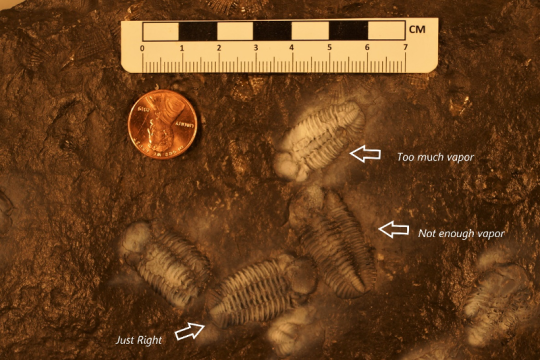
Figure 1: CM 5881 Trilobite (Isotelus maximus) with “smoke”

Figure 2: Same Trilobite without “smoke”
Ever wonder how scientists make fossils jump off the printed page? Enter a centuries-old technique known as “smoking fossils.” While there are many ways to “smoke” a fossil, one of the more commonly used methods was refined by paleontologist-geologist, Dr. Curtis Teichert. In 1948, he developed a process to heat aluminum chloride powder in a test tube with the result creating a white vapor that could be applied with a pump to a fossil. Although the Teichert process involves vapor rather than smoke; you will hear it informally referred to as “smoking fossils.” Today, Dr. Teichert’s method is still practiced behind a set of metal doors in the basement of the Carnegie Museum of Natural History with one modification: a ventilator hood runs at a low hum in order to remove vapors circulating in the air during the “smoking” process.
A few weeks ago, Albert Kollar, Collections Manager for the Section of Invertebrate Paleontology, “smoked” a few fossils for an upcoming blog post on state fossils. As Teichert noted in 1948, “… the application of a white coating to fossils is essential for photographic reproduction in order to eliminate spottiness and to bring about fine structural details otherwise lost on a black background.” One of the fossils selected by Albert was a 480-million-year-old trilobite (Figures 1 and 2). Trilobites are an extinct group of marine animals with an exoskeleton. In Figure 1, all three segments of the body are easy to see. The cephalon (head), thorax (mid-section), and pygidium (end) are well defined and the calcite crystal eyes stand out. By contrast, the same fossil without “smoke” (Figure 2) is difficult to study because it appears to merge with the rock.
It takes years of practice to add the aluminum chloride vapor with precision. Too much vapor gives the fossil a hazy appearance and it makes it difficult to see the fine details, while too little vapor imparts a splotchy appearance with some details visible and others disappearing into the stone. Albert selected a “death assemblage,” or group of fossils that died on the sea floor, to illustrate the art of getting the vapor just right (Figure 3). And how long does the vapor last? Albert explained that the effect can last up to a week if left in a closed cabinet, but it can also be removed with a damp cloth anytime.

Figure 3: PA State Fossil (CM 53898) – Trilobite (Phacops rana) with too much, not enough and just enough “smoke”
So, the next time you are enjoying a photo of a fossil on exhibit or in a magazine, look for evidence of “smoke.” It is just one more way that scientists help to bring ancient creatures to life.
Joann Wilson is a volunteer with the Section of Invertebrate Paleontology and Albert Kollar is Collections Manager for the Section of Invertebrate Paleontology at Carnegie Museum of Natural History. Museum staff, volunteers, and interns are encouraged to blog about their unique experiences and knowledge gained from working at the museum.
